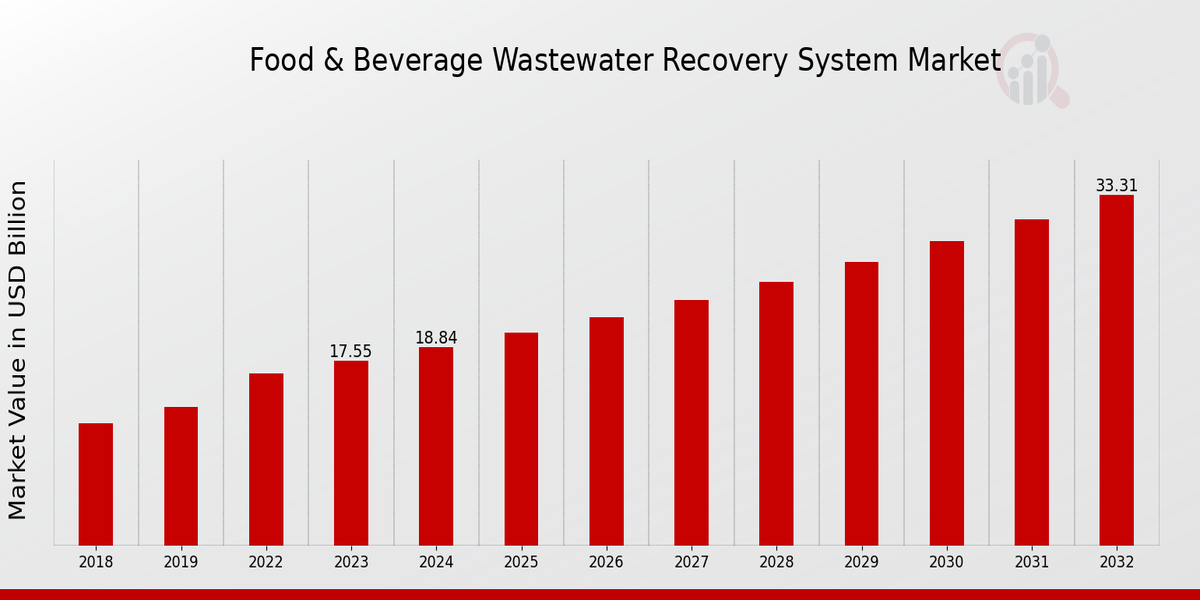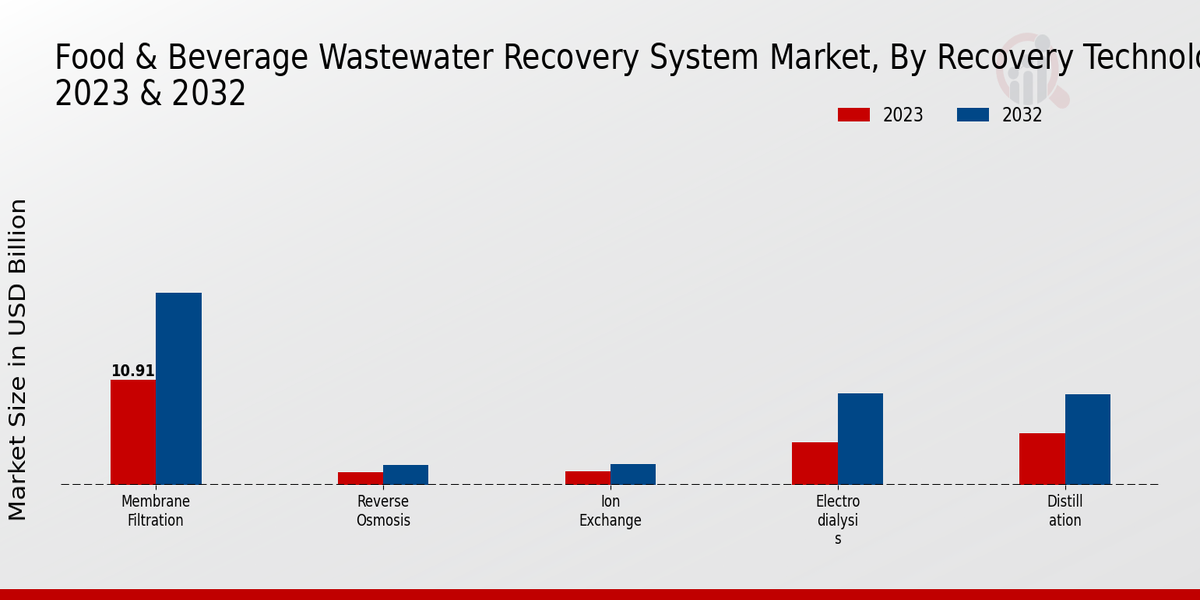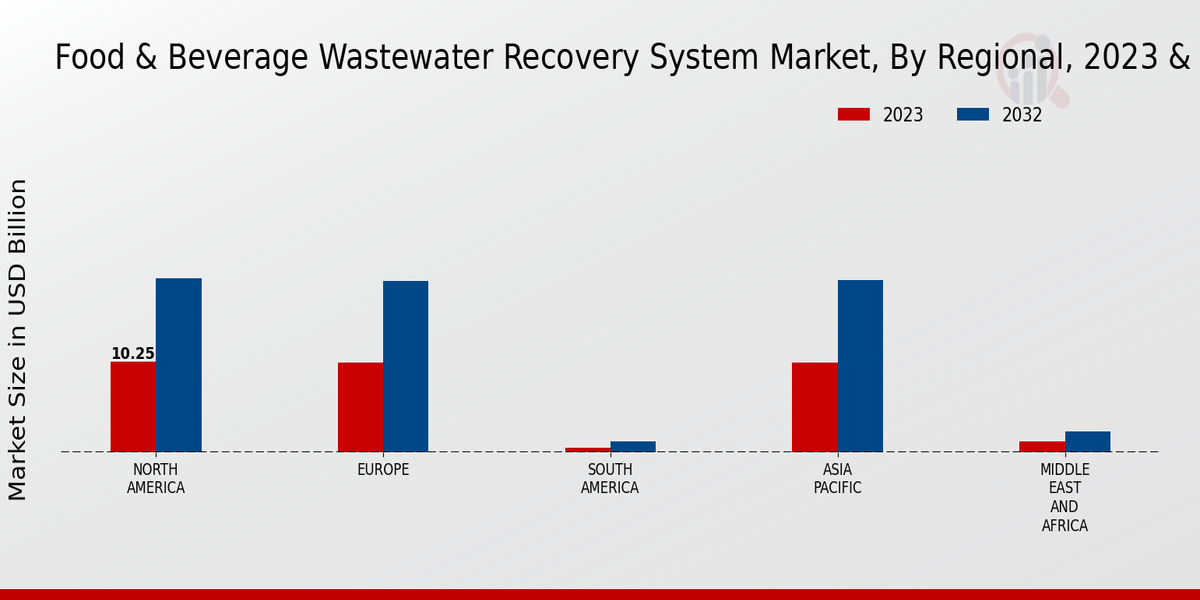Global Food Beverage Wastewater Recovery System Market Overview
As per MRFR analysis, the Food Beverage Wastewater Recovery System Market Size was estimated at 20.23 (USD Billion) in 2024. The Food Beverage Wastewater Recovery System Market Industry is expected to grow from 21.73 (USD Billion) in 2025 to 41.24 (USD Billion) till 2034, at a CAGR (growth rate) is expected to be around 7.38% during the forecast period (2025 - 2034).
Key Food Beverage Wastewater Recovery System Market Trends Highlighted
The Food Beverage Wastewater Recovery System Market is witnessing significant growth, driven by stringent environmental regulations, rising water scarcity, and increasing awareness about sustainability. Key market drivers include the adoption of advanced technologies for efficient water treatment, government incentives promoting wastewater reuse, and the need for cost-effective solutions to manage wastewater discharge. Opportunities lie in the exploration of innovative technologies for energy-efficient treatment and the development of decentralized systems for wastewater treatment and reuse. Recent trends include the integration of IoT and automation in wastewater recovery systems, leading to improved monitoring and control. Additionally, the market is witnessing a growing demand for customized solutions tailored to specific industry requirements. The market is expected to expand in the coming years, driven by these key drivers and evolving trends.
Source: Primary Research, Secondary Research, MRFR Database and Analyst Review
Food Beverage Wastewater Recovery System Market Drivers
Rising Demand for Water Conservation and Environmental Sustainability
Demand in the Food Beverage Wastewater Recovery System Market Industry is experiencing robust growth at present. Governments across the world are increasingly implementing strict regulations to lower water consumption as well as decrease wastewater discharge. In addition to these contributing factors, the escalating utilization of wastewater recovery systems among producers in food and beverage will further boost their growth in the market.Low water usage and less wastewater generation water recovery systems provide companies the capacity to recycle and reuse water in their internal production processes. This will indeed continue to boost market growth over the forecast period.
Technological Advancements and Innovation
The Food Beverage Wastewater Recovery System Market Industry is experiencing substantial technological advancements that are enhancing the efficiency and effectiveness of wastewater recovery systems. For instance, the advancements in membrane technologies such as ultrafiltration and reverse osmosis are facilitating companies to achieve higher water recovery rates and improve water quality. Furthermore, other advances, such as the incorporation of sensors, automated control systems, and data analytics, are optimizing the performance of wastewater recovery systems while lowering operating costs and reducing maintenance requirements.All of these technological developments are making wastewater recovery systems more attainable and cost-effective in Food and Beverage Companies and accelerating the growth of the market.
Increasing Focus on Water Reuse and Circular Economy
The Food Beverage Wastewater Recovery System Market Industry is gaining traction owing to the push by companies towards a circular economy, avoiding waste and utilizing more resources. Recovery of wastewater and reutilization by food and beverage companies can reduce the environmental impact considerably leading them to a more sustainable environment. Also, the recovered water for irrigation or for other industrial purposes adds on as another revenue for companies.Increasing adoption of water reuse put forth by the drive towards a circular economy shall bring about considerable growth in the wastewater recovery system market.
Food Beverage Wastewater Recovery System Market Segment Insights:
Food Beverage Wastewater Recovery System Market Recovery Technology Insights
The Food Beverage Wastewater Recovery System Market is segmented into various recovery technologies, including Membrane Filtration, Reverse Osmosis, Ion Exchange, Electrodialysis, and Distillation. Each technology offers unique advantages and is applicable to specific wastewater treatment requirements. Membrane Filtration: Membrane Filtration is a widely adopted technology in the Food Beverage Wastewater Recovery System Market, accounting for a significant share of the overall revenue. It utilizes semi-permeable membranes to separate contaminants and impurities from wastewater, allowing for the recovery of valuable resources. Membrane Filtration is particularly effective in removing suspended solids, bacteria, and viruses, making it suitable for various applications within the food and beverage industry. The market for Membrane Filtration is expected to continue growing due to its efficiency and versatility. Reverse Osmosis: Reverse Osmosis is another prominent technology in the Food Beverage Wastewater Recovery System Market. It employs a semi-permeable membrane to remove dissolved solids, salts, and other impurities from wastewater. Reverse Osmosis is highly effective in producing high-quality water suitable for reuse or discharge.The technology is gaining traction in regions facing water scarcity and stringent environmental regulations. The market for Reverse Osmosis is projected to witness significant growth in the coming years. Ion Exchange: Ion Exchange is a well-established technology used in the Food Beverage Wastewater Recovery System Market. It involves passing wastewater through a resin bed that selectively removes specific ions or contaminants. Ion Exchange is commonly employed to remove heavy metals, nitrates, and other undesirable ions from wastewater. The technology is widely used in various industrial applications, including food and beverage processing. The market for Ion Exchange is anticipated to grow steadily as industries seek cost-effective wastewater treatment solutions. Electrodialysis: Electrodialysis is a specialized technology gaining attention in the Food Beverage Wastewater Recovery System Market. It utilizes an electrical field to separate ions and other charged particles from wastewater. Electrodialysis is particularly effective in removing salts and other dissolved solids, making it suitable for treating high-salinity wastewater. The technology is expected to witness growing adoption in regions facing water scarcity and desalination needs.Distillation: Distillation is a traditional yet effective technology used in the Food Beverage Wastewater Recovery System Market. It involves evaporating wastewater and condensing the vapor to produce clean water. Distillation is a highly effective method for removing impurities and contaminants, resulting in high-quality water suitable for various applications. The market for Distillation is expected to remain stable, with potential growth in regions where access to clean water is a challenge.
Source: Primary Research, Secondary Research, MRFR Database and Analyst Review
Food Beverage Wastewater Recovery System Market Recovery Type Insights
The Food Beverage Wastewater Recovery System Market is classified by recovery type into “water recovery, biogas recovery, nutrient recovery and energy recovery”. Of them, the water recovery segment is predicted to dominate the market in the near future. The water recovery segment of the Food Beverage Wastewater Recovery System Market revenue accounted for the highest share in 2023. The high demand for water recovery systems is due to the increasing demand for water conservation and reuse in the food and beverage industry. The stringent environmental regulations and growing water scarcity continue to push the growth of water recovery technologies.The water recovered from waste can be used for various purposes, such as irrigation, cleaning, cooling, etc., which reduces water use and costs. Further, the growth of the water recovery segment of the Food Beverage Wastewater Recovery System Market is supported by government initiatives and subsidies to promote water conservation.
Food Beverage Wastewater Recovery System Market Application Insights
The Food Beverage Wastewater Recovery System Market is segmented based on application into the dairy industry, meat processing industry, fruit and vegetable processing industry, breweries and wineries, and soft drink and juice industry. Among these, the dairy industry segment is expected to hold the largest market share in 2023, owing to the increasing demand for dairy products and the stringent regulations imposed on wastewater discharge in the dairy industry. The meat processing industry segment is also expected to witness significant growth, driven by the rising demand for meat products and the need to reduce water consumption in meat processing plants.The fruit and vegetable processing industry segment is expected to grow at a steady pace as the demand for processed fruits and vegetables increases. The breweries and wineries segment is also expected to experience growth due to the increasing popularity of craft beers and wines. The soft drink and juice industry segment is expected to grow at a moderate pace, driven by the increasing demand for packaged beverages.
Food Beverage Wastewater Recovery System Market Flow Rate Insights
The Food Beverage Wastewater Recovery System Market segmentation by flow rate offers valuable insights into the market dynamics. The market is segmented into three primary flow rate categories: Low Flow (less than 100 m3/day): This segment caters to smaller food and beverage facilities that generate a relatively low volume of wastewater. In 2023, the low-flow segment accounted for approximately 30% of the global market revenue. It is projected to maintain a steady growth rate, driven by increasing awareness of wastewater treatment regulations and the need for cost-effective solutions for small-scale facilities.Medium Flow (100-1000 m3/day): This segment represents a significant portion of the market, accounting for around 45% of the Food Beverage Wastewater Recovery System Market revenue in 2023. Medium-sized food and beverage facilities typically have higher wastewater generation rates, making them a key target market for wastewater recovery systems. The segment is expected to witness steady growth as industries expand and upgrade their wastewater treatment infrastructure. High Flow (more than 1000 m3/day): The high-flow segment caters to large-scale food and beverage facilities that generate substantial volumes of wastewater.In 2023, this segment held a 25% share of the global market revenue. The growth of this segment is anticipated to be driven by stringent environmental regulations and the need for efficient wastewater management solutions in large-scale production facilities.
Food Beverage Wastewater Recovery System Market Source Insights
The Food Beverage Wastewater Recovery System Market is segmented by source into Industrial Wastewater and Municipal Wastewater. The Industrial Wastewater segment accounted for the larger market share in 2023 and is estimated to continue to dominate the market throughout the forecast period. The growth of the Industrial Wastewater segment can be attributed to the increasing demand for water conservation and wastewater treatment solutions in industries such as food processing, beverages, and pharmaceuticals. The Municipal Wastewater segment is also expected to witness significant growth during the forecast period, owing to the growing population and urbanization, which is leading to an increase in the generation of wastewater.
Food Beverage Wastewater Recovery System Market Regional Insights
The regional segmentation of the Food Beverage Wastewater Recovery System Market offers valuable insights into the industry's growth dynamics. North America is expected to continue dominating the market, driven by stringent environmental regulations and increasing adoption of sustainable practices. Europe is another major market, characterized by a high concentration of food and beverage processing facilities and supportive government policies. APAC is projected to witness significant growth, fueled by rising demand for processed foods and increasing awareness about water scarcity.South America and MEA are emerging markets with immense potential, as they face challenges related to water scarcity and the need for efficient wastewater management. Overall, the regional segmentation provides a comprehensive understanding of the market landscape, enabling stakeholders to identify key growth opportunities and develop targeted strategies.
Source: Primary Research, Secondary Research, MRFR Database and Analyst Review
Food Beverage Wastewater Recovery System Market Key Players And Competitive Insights:
Partnerships, mergers, and acquisitions are some of the key strategies adopted by the major players in the Food Beverage Wastewater Recovery System Market to stay ahead of the competition. Through the merging of resources, experts, and technologies, players are able to come up with some innovative products and services. For example, in June 2023, France-based global water treatment and recovery company Suez announced a strategic alliance with the Commonwealth Scientific and Industrial Research Organisation to develop advanced technologies for wastewater treatment and recovery in the food and beverage industry. The alliance will enable the companies to better utilize water, cut costs, and make the industry more sustainable. In addition to this, leading players in the Food Beverage Wastewater Recovery System Market are pushing to invest in their product line to meet the constantly changing market needs. They have invested in research and development to come up with new products that take care of the dynamic requirements of the market.
Key players in the Food Beverage Wastewater Recovery System Market have adopted the strategy of offering solutions that are tailor-made for each of their customers. They have come up with a number of products and services that address the different challenges that the various industries in the food and beverage sector face in handling wastewater. For example, France-based Veolia, a leading global water and waste company, has developed customized waste handling solutions, water audits, process optimization, and tailor-made designs for the treatment of wastewater for the food and beverage industry. In conclusion, a company that operates in this market and is a key competitor to Veolia is Xylem. Xylem is a New York-based global water technology company and a leading global provider of water and waste treatment solutions in the industrial sector. Xylem provides MBRs and other technologies based on RO and UF. Since these products are specially designed for food and beverage companies, they make the recovery of waste more efficient.
Key Companies in the Food Beverage Wastewater Recovery System Market Include:
- Alfa Laval
- ITT Corporation
- Evoqua Water Technologies
- Jellyfish Technologies
- Cherne Industries
- Veolia Water Technologies
- Suez Water Technologies Solutions
- Xylem
- Aquatech International
- GE Water Process Technologies
- Siemens
- Pentair
- Danfoss
- Clearwater Industries
Food Beverage Wastewater Recovery System Market Industry Developments
The Food Beverage Wastewater Recovery System Market size was valued at 21.73 billion USD in 2025 and is projected to reach 41.24 billion USD by 2034, exhibiting a CAGR of 7.38% during the forecast period. The market growth is attributed to the increasing demand for water conservation, stringent government regulations on wastewater discharge, and technological advancements in wastewater treatment processes. Key industry participants include Veolia, Suez, Xylem, Evoqua Water Technologies, and GE Water Process Technologies. Recent developments include Veolia's acquisition of Suez's water business, expanding its presence in the wastewater treatment sector. The growing adoption of membrane bioreactors (MBRs) and reverse osmosis (RO) systems for efficient wastewater treatment is expected to drive market growth.Food Beverage Wastewater Recovery System Market Segmentation InsightsFood Beverage Wastewater Recovery System Market Recovery Technology Outlook
- Membrane Filtration
- Reverse Osmosis
- Ion Exchange
- Electrodialysis
- Distillation
Food Beverage Wastewater Recovery System Market Recovery Type Outlook
- Water Recovery
- Biogas Recovery
- Nutrient Recovery
- Energy Recovery
Food Beverage Wastewater Recovery System Market Application Outlook
- Dairy Industry
- Meat Processing Industry
- Fruit and Vegetable Processing Industry
- Breweries and Wineries
- Soft Drink and Juice Industry
Food Beverage Wastewater Recovery System Market Flow Rate Outlook
- Low Flow (less than 100 m3/day)
- Medium Flow (100-1000 m3/day)
- High Flow (more than 1000 m3/day)
Food Beverage Wastewater Recovery System Market Source Outlook
- Industrial Wastewater
- Municipal Wastewater
Food Beverage Wastewater Recovery System Market Regional Outlook
- North America
- Europe
- South America
- Asia Pacific
- Middle East and Africa
| Report Attribute/Metric |
Details |
|
Market Size 2024
|
20.23 (USD Billion)
|
|
Market Size 2025
|
21.73 (USD Billion)
|
|
Market Size 2034
|
41.24 (USD Billion)
|
|
Compound Annual Growth Rate (CAGR)
|
7.38% (2025 - 2034)
|
|
Report Coverage
|
Revenue Forecast, Competitive Landscape, Growth Factors, and Trends
|
|
Base Year
|
2024
|
|
Market Forecast Period
|
2025 - 2034
|
|
Historical Data
|
2019 - 2023
|
| Market Forecast Units |
USD Billion |
| Key Companies Profiled |
Alfa Laval, ITT Corporation, Evoqua Water Technologies, Jellyfish Technologies, Cherne Industries, Veolia Water Technologies, Suez Water Technologies Solutions, Xylem, Aquatech International, GE Water Process Technologies, Siemens, Pentair, Danfoss, Clearwater Industries |
| Segments Covered |
Recovery Technology, Recovery Type, Application, Flow Rate, Source, Regional |
| Key Market Opportunities |
Growing demand for water conservation Government incentives Increasing adoption of advanced technologies Rising awareness of environmental sustainability Integration of wastewater recovery systems with other industrial processes |
| Key Market Dynamics |
Increasing water scarcity government regulations demand resource efficiency, technological advancements and growing awareness of sustainability |
| Countries Covered |
North America, Europe, APAC, South America, MEA |
Frequently Asked Questions (FAQ) :
The Food Beverage Wastewater Recovery System Market is expected to reach a valuation of 41.24 billion USD by 2034.
The Food Beverage Wastewater Recovery System Market is projected to grow at a CAGR of 7.38% from 2025 to 2034.
North American region is expected to hold the largest market share in the Food Beverage Wastewater Recovery System Market by 2032.
Key applications of Food Beverage Wastewater Recovery Systems include water reuse, energy recovery, and nutrient recovery.
Key competitors in the Food Beverage Wastewater Recovery System Market include Veolia, Suez, and Evoqua Water Technologies.
Major drivers of growth in the Food Beverage Wastewater Recovery System Market include increasing water scarcity, rising energy costs, and stringent environmental regulations.
Challenges faced by the Food Beverage Wastewater Recovery System Market include high capital costs, complex technology, and lack of skilled labor.
Opportunities in the Food Beverage Wastewater Recovery System Market include technological advancements, increasing government support, and growing awareness of sustainability.
Industry 4.0 is expected to bring significant advancements to the Food Beverage Wastewater Recovery System Market, such as improved efficiency, reduced costs, and increased sustainability.
Key trends in the Food Beverage Wastewater Recovery System Market include the adoption of membrane technologies, the integration of renewable energy sources, and the development of smart systems.

















